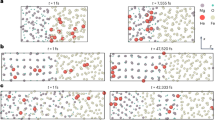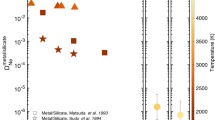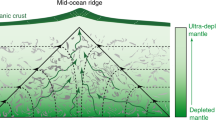Abstract
Radioactive decay of uranium and thorium produces 4He, whereas 3He in the Earth’s mantle is not produced by radioactive decay and was only incorporated during accretion—that is, it is primordial1. 3He/4He ratios in many ocean-island basalts (OIBs) that erupt at hotspot volcanoes, such as Hawaii and Iceland, can be up to sixfold higher than in mid-ocean ridge basalts (MORBs). This is inferred to be the result of outgassing by melt production at mid-ocean ridges in conjunction with radiogenic ingrowth of 4He, which has led to a volatile-depleted upper mantle (MORB source) with low 3He concentrations and low 3He /4He ratios2,3,4,5,6. Consequently, high 3He/4He ratios in OIBs are conventionally viewed as evidence for an undegassed, primitive mantle source, which is sampled by hot, buoyantly upwelling deep-mantle plumes3,6,7. However, this conventional model provides no viable explanation of why helium concentrations and elemental ratios of He/Ne and He/Ar in OIBs are an order of magnitude lower than in MORBs. This has been described as the ‘helium concentration paradox’8 and has contributed to a long-standing controversy about the structure and dynamics of the Earth’s mantle. Here we show that the helium concentration paradox, as well as the full range of noble-gas concentrations observed in MORB and OIB glasses, can self-consistently be explained by disequilibrium open-system degassing of the erupting magma. We show that a higher CO2 content in OIBs than in MORBs leads to more extensive degassing of helium in OIB magmas and that noble gases in OIB lavas can be derived from a largely undegassed primitive mantle source.
This is a preview of subscription content, access via your institution
Access options
Subscribe to this journal
Receive 51 print issues and online access
$199.00 per year
only $3.90 per issue
Buy this article
- Purchase on Springer Link
- Instant access to full article PDF
Prices may be subject to local taxes which are calculated during checkout




Similar content being viewed by others
References
Porcelli, D. & Ballentine, C. J. Models for the distribution of terrestrial noble gases and evolution of the atmosphere. Rev. Mineral. Geochem. 47, 411–480 (2002)
Hart, R., Dymond, J. & Hogan, L. Preferential formation of the atmosphere–sialic crust system from the upper mantle. Nature 278, 156–159 (1979)
Kurz, M. D., Jenkins, W. J. & Hart, S. R. Helium isotopic systematics of oceanic islands and mantle heterogeneity. Nature 297, 43–47 (1982)
Allègre, C. J., Staudacher, T., Sarda, P. & Kurz, M. Constraints on evolution of Earth’s mantle from rare-gas systematics. Nature 303, 762–766 (1983)
O’Nions, R. K. & Oxburgh, E. R. Heat and helium in the Earth. Nature 306, 429–431 (1983)
Kellogg, L. H. & Wasserburg, G. J. The role of plumes in mantle helium fluxes. Earth Planet. Sci. Lett. 99, 276–289 (1990)
Morgan, W. J. Convective plumes in lower mantle. Nature 230, 42–43 (1971)
Anderson, D. L. The helium paradoxes. Proc. Natl Acad. Sci. USA 95, 4822–4827 (1998)
Helfrfrich, G. R. & Wood, B. J. The Earth’s mantle. Nature 412, 501–507 (2001)
Anderson, D. L. A model to explain the various paradoxes associated with mantle noble gas geochemistry. Proc. Natl Acad. Sci. USA 95, 9087–9092 (1998)
Graham, D. W. Noble gas isotope geochemistry of mid-ocean ridge and ocean island basalts: Characterization of mantle source reservoirs. Rev. Mineral. Geochem. 47, 247–317 (2002)
Fisher, D. E. Noble gases from oceanic island basalts do not require an undepleted mantle source. Nature 316, 716–718 (1985)
Honda, M. & Patterson, D. B. Systematic elemental fractionation of mantle-derived helium, neon, and argon in mid-oceanic ridge glasses. Geochim. Cosmochim. Acta 63, 2863–2874 (1999)
Moreira, M. & Sarda, P. Noble gas constraints on degassing processes. Earth Planet. Sci. Lett. 176, 375–386 (2000)
Dixon, J. E. & Clague, D. A. Volatiles in basaltic glasses from Loihi seamount, Hawaii: Evidence for a relatively dry plume component. J. Petrol. 42, 627–654 (2001)
Paonita, A. & Martelli, M. A new view of the He–Ar–CO2 degassing at mid-ocean ridges: Homogeneous composition of magmas from the upper mantle. Geochim. Cosmochim. Acta 71, 1747–1763 (2007)
Carroll, M. R. & Stolper, E. M. Noble gas solubilities in silicate melts and glasses: New experimental results for argon and the relationship between solubility and ionic porosity. Geochim. Cosmochim. Acta 57, 5039–5051 (1993)
Burnard, P., Harrison, D., Turner, G. & Nesbitt, R. Degassing and contamination of noble gases in Mid-Atlantic Ridge basalts. Geochem. Geophys. Geosyst. 4, 10.1029/2002GC000326. (2003)
Aubaud, C., Pineau, F., Jambon, A. & Javoy, M. Kinetic disequilibrium of C, He, Ar and carbon isotopes during degassing of mid-ocean ridge basalts. Earth Planet. Sci. Lett. 222, 391–406 (2004)
Lensky, N. G., Navon, O. & Lyakhovsky, V. Bubble growth during decompression of magma: experimental and theoretical investigation. J. Volcanol. Geotherm. Res. 129, 7–22 (2004)
Dixon, J. E. Degassing of alkalic basalts. Am. Mineral. 82, 368–378 (1997)
Hilton, D. R. et al. Controls on magmatic degassing along the Reykjanes Ridge with implications for the helium paradox. Earth Planet. Sci. Lett. 183, 43–50 (2000)
Honda, M. et al. Possible solar noble-gas component in Hawaiian basalts. Nature 349, 149–151 (1991)
Honda, M. & McDougall, I. Primordial helium and neon in the Earth—a speculation on early degassing. Geophys. Res. Lett. 25, 1951–1954 (1998)
Javoy, M. & Pineau, F. The volatiles record of a ‘popping’ rock from the Mid-Atlantic Ridge at 14° N: chemical and isotopic composition of gas trapped in the vesicles. Earth Planet. Sci. Lett. 107, 598–611 (1991)
Moreira, M., Kunz, J. & Allègre, C. J. Rare gas systematics in popping rock: Isotopic and elemental compositions in the upper mantle. Science 279, 1178–1181 (1998)
Sarda, P. & Graham, D. Mid-ocean ridge popping rocks: implications for degassing at ridge crests. Earth Planet. Sci. Lett. 97, 268–289 (1990)
Ballentine, C. J., van Keken, P. E., Porcelli, D. & Hauri, E. H. Numerical models, geochemistry and the zero-paradox noble-gas mantle. Phil. Trans. R. Soc. Lond. A 360, 2611–2631 (2002)
Holloway, J. R. Graphite-melt equilibria during mantle melting: constraints on CO2 in MORB magmas and the carbon content of the mantle. Chem. Geol. 147, 89–97 (1998)
Saal, A. E., Hauri, E. H., Langmuir, C. H. & Perfit, M. R. Vapour undersaturation in primitive mid-ocean-ridge basalt and the volatile content of Earth’s upper mantle. Nature 419, 451–455 (2002)
Head, J. W., Wilson, L. & Smith, D. K. Mid-ocean ridge eruptive vent morphology and substructure: Evidence for dike widths, eruption rates, and evolution of eruptions and axial volcanic ridges. J. Geophys. Res. 101, 28265–28280 (1996)
Hilton, D. R., McMurtry, G. M. & Goff, F. Large variations in vent fluid CO2/3He ratios signal rapid changes in magma chemistry at Loihi seamount, Hawaii. Nature 396, 359–362 (1998)
Resing, J. A., Lupton, J. E., Feely, R. A. & Lilley, M. D. CO2 and 3He in hydrothermal plumes: implications for mid-ocean ridge CO2 flux. Earth Planet. Sci. Lett. 226, 449–464 (2004)
Acknowledgements
We thank C. Ballentine for a constructive review; M. Saar and J. Rice for providing computational resources; C. Langmuir for helpful suggestions; and R. O’Connell, S. Parman and S. Jacobsen for discussions. H.M.G. was supported by the Daly Fellowship (Department of Earth and Planetary Sciences, Harvard University).
Author information
Authors and Affiliations
Corresponding author
Ethics declarations
Competing interests
The authors declare no competing financial interests.
Supplementary information
Supplementary Information
The file contains Supplementary Notes, Supplementary Figures S1-S5 with Legends and additional references. (PDF 3129 kb)
Rights and permissions
About this article
Cite this article
Gonnermann, H., Mukhopadhyay, S. Non-equilibrium degassing and a primordial source for helium in ocean-island volcanism. Nature 449, 1037–1040 (2007). https://doi.org/10.1038/nature06240
Received:
Accepted:
Issue Date:
DOI: https://doi.org/10.1038/nature06240
Comments
By submitting a comment you agree to abide by our Terms and Community Guidelines. If you find something abusive or that does not comply with our terms or guidelines please flag it as inappropriate.



